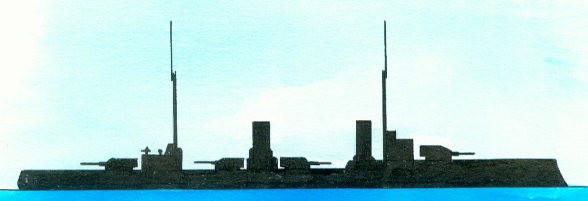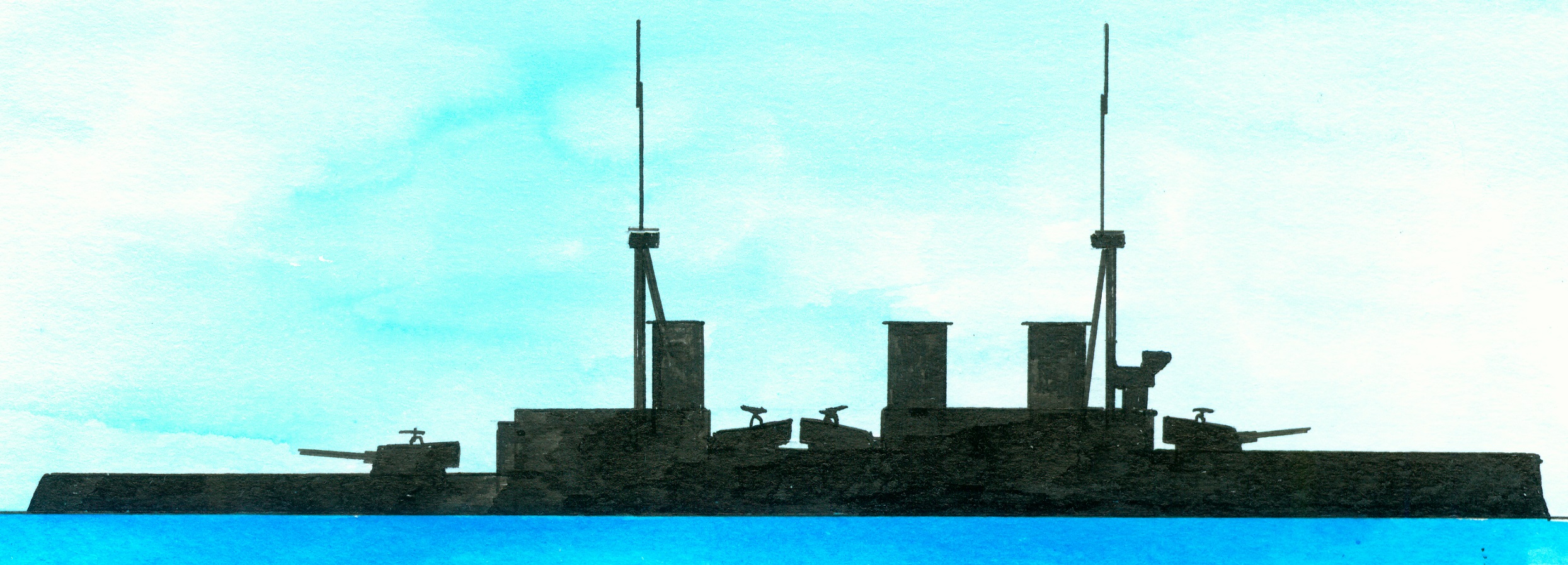German SMS Von der Tann
British Invincible-class
An item reported that in contrary to earlier items the German magazine Marine Rundschau now reported that the large cruiser Von der Tann (1) was armed with 8-28cm guns, 10-15cm guns and 16-8,8cm guns. Nothing was said above the torpedo armament or her armour. Another German magazine Schiffbau compared her with the British Invincible-class battle cruisers (2) and concluded that her smaller main guns (28cm against the 30,5cm of the Invincible-class) was a disadvantage. Otherwise she had several advantages: 1 mile higher speed, gun turrets amidships had a better range and a valuable armoured secondary armament of 10-15cm guns. She was not fitted out with torpedo nets.
Notes
1. Laid down at the shipyard of Blohm&Voss, Hamburg, Germany on 21 March 1908, launched on 20 March 1909, baptized on 1 September 1910, commissioned on 20 March 1909, interned after the First World War at Scapa Flow, Orkney Islands, Scotland but scuttled by her own crew to prevent that she fell into British hands on 21 June 1919 and in the 1930s raised and broken up at Rosyth. Her homeport Was Kiel, Germany. Displacement 19.370 tons/19.060 long tons (design)-21.300 tons/21.000 long tons (full loaded) and as dimensions 171,7 x 26,6 x 8,91 (design)-9,17 (full loaded) metres or 563.4 x 87.3 x 29.3-30.1 feet. Fitted out with 18 Schulz-Thornycroft boilers and 4 Parsons steam turbines supplying via 4 screws 41.426 shop allowing a speed of 24,8 (design)-27,75 (maximum) knots and with a speed of 14 knots a range of 4.400 nautical miles. The armour consisted of 8-25cm/(3.1-9.8” thick belt, 2,5cm/0.98” thick torpedo bulkheads, gun turrets protected by 230cm/9.1” and the conning tower by 25cm/9.8“. The armament consisted of 4x2-28cm SK L/45 guns fore and aft 1 turret, 2 amidships)/, 10x1-15cm SK L/45 guns (casemated) 16-8,8cm SK L/45 guns and 4-18” torpedo tubes. Her crew numbered 923 men included 41 officers. Speed 24,8-27,75 (maximum) knots.
2. Invincible-class consisting of the Invincible, Indomitable and Inflexible. HMS Invincible laid down at the shipyard of Armstrong, Whitworth&Co. Ltd, Tyneside, Elswick, England on 2 April 1906, launched at 3 p.m. by Lady Allendale on 13 April 1907, officially completed on 16 March 1909, commissioned on 20 March 1909 and sunk on 31 May 1916 during the Battle of Jutland when a magazine exploded after the Q turret was hit. Building costs 1.725.739 (with guns)-1.768.995 (without guns) pound sterling. The concept for the Invincible-class battle cruisers came from the British admiral Sir John Fisher.(1) The idea was to design a ship fast enough to escape from stronger opponents like battleships and strong enough to destroy nearly all other ships while the battle cruisers were as heavily armed as most of the battleships of their time. General technical specifications of this class. A displacement of 17.530 tons/17.250 long tons (loaded)-20.750 tons20.420 long tons (deep loaded) and as dimensions 172,8 (over all) x 23,9 x 9,1 (deep loaded) metres or 567 x 78.5 x 30 feet. The two paired sets of Parsons direct-drive steam turbines and 31 Yarrow water tube boilers supplied via 4 shafts 41.000 shp (design) allowing a speed of 25 (design)-26 (trials) knots and with a speed of 10 knots and maximum coal bunker capacity of 3.050 tons/3.000 long tons and 737 tons/725 long tons fuel-oil a range of 3.090 nautical miles. The crew numbered 784 men. The armour consisted of a 10,2-15,2cm-4-6” thick belt, 3,8-6,4cm/1.5-2,5” thick decks, 6,4cm/2.5” thick torpedo bulkheads with the gun turrets, barbettes and conning tower protected by respectively 17,8cm/7”, 17,8cm/7” and 15,2-25,4cm/6-10”. The armament consisted of 4x2-30,5cm/12” Mk X breech loading guns. 16x1-10,2cm/4” quick firing Mk III guns, 7 Maxim guns and 5z1-45cm/18” submerged torpedo tubes. The Inflexible and Indomitable were around 1918 also fitted out with a Sopwith Pup and a Sopwith 1½ Strutter. Their flying-off platforms fitted out with a canvas hangar were situated on top of the P and Q turrets.


